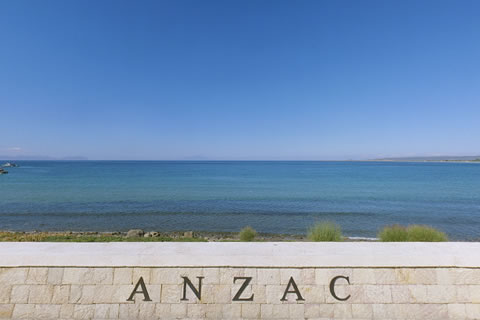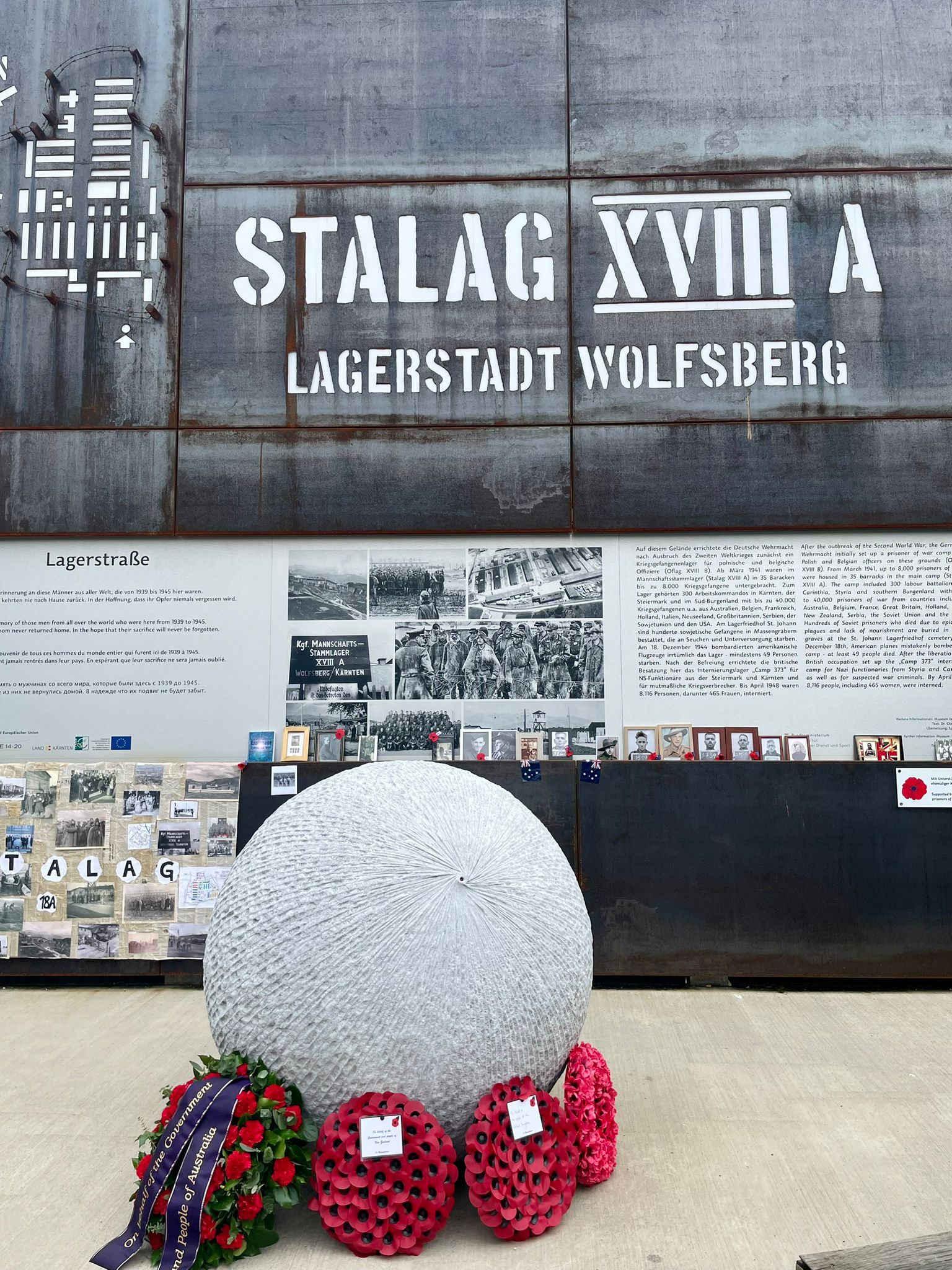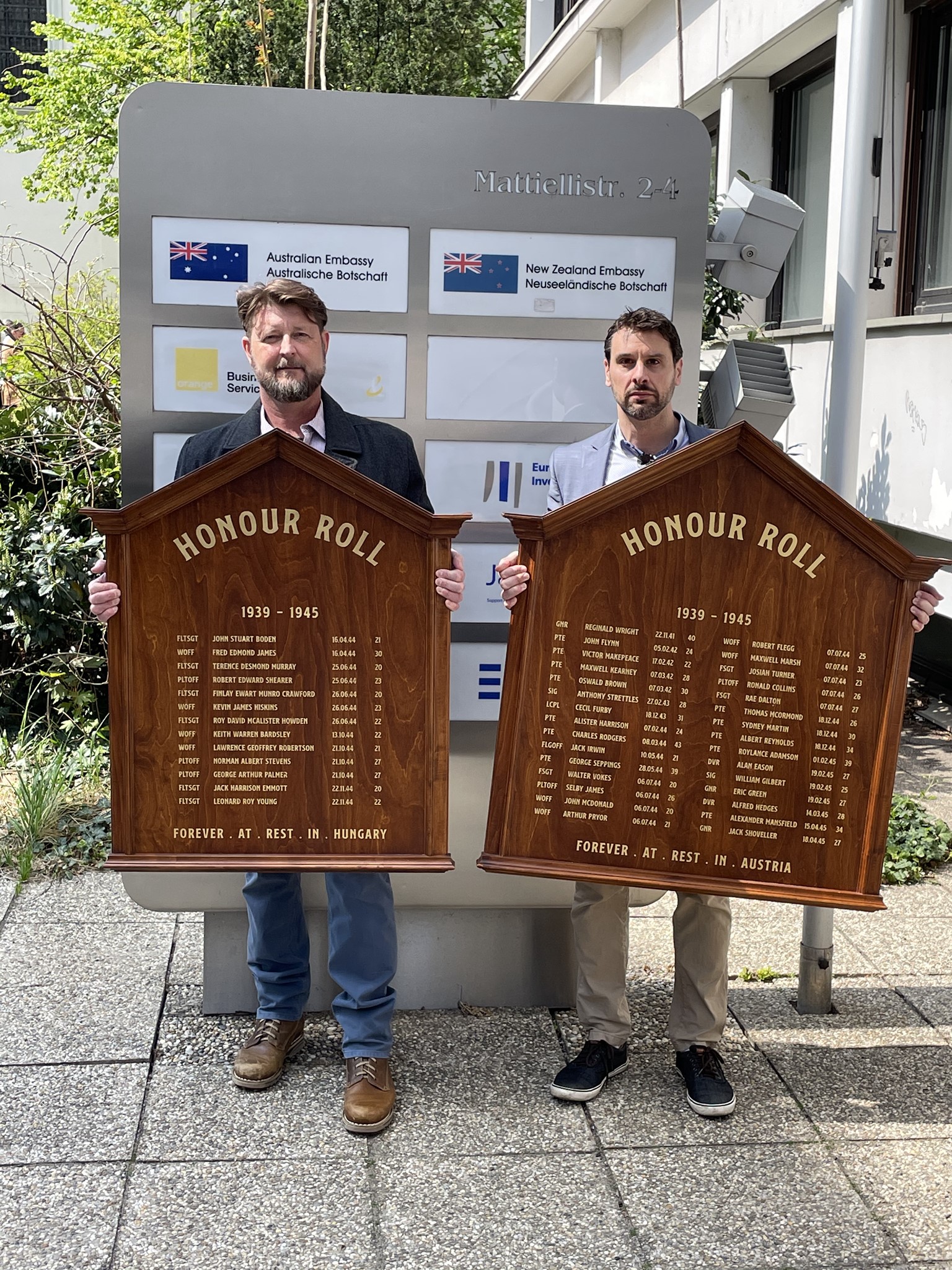Anzac Day
 Anzac Day, 25 April, is one of Australia's and New Zealand's most important national occasions. It marks the anniversary of the Australian and New Zealand Army Corps (ANZAC) landing in Gallipoli in 1915, the first major military action fought by Australian and New Zealand forces during the First World War.
Anzac Day, 25 April, is one of Australia's and New Zealand's most important national occasions. It marks the anniversary of the Australian and New Zealand Army Corps (ANZAC) landing in Gallipoli in 1915, the first major military action fought by Australian and New Zealand forces during the First World War.
The soldiers who landed in Gallipoli quickly became known as Anzacs, and the pride they took in that name endures to this day. The spirit of the original Anzacs — courage, mateship and sacrifice — has passed to all who served our countries. This spirit forms part of Australia's and New Zealand’s national identities.
Anzac Day is a day of national remembrance for Australians and New Zealanders. We remember and reflect on the service of our men and women in all conflicts and in peacekeeping operations. We honour those who gave the ultimate sacrifice so that our nations may enjoy the freedoms they have today. And we pay our respects to those who continue to serve our nations today.
Commemorating Anzacs in Central Europe 
Each year on Anzac Day, 25 April, the Australian and New Zealand Embassies host a dawn service in Vienna. This service is open to members of the public and typically held at Karlsplatz, with details confirmed on our social media pages ahead of time.
On Remembrance Day on 11 November, diplomats of the Australian Embassy travel throughout the region to represent the Australian government and lay commemorative wreaths at Remembrance Day services, typically held at the Commonwealth War Cemetery in Klagenfurt, Austria; the Commonwealth War Cemetery in Solymar, Hungary; and the Monument to British Airmen in Čunovo, Slovakia.
An honour roll of the 43 Australians interred at the cemeteries in Klagenfurt and Solymar is located further down this page.
Stalag XVIIIA Prisoner of War Camp
 Stalag XVIII-A was a World War II German Army prisoner-of-war camp located near the town of Wolfsberg, Carinthia.
Stalag XVIII-A was a World War II German Army prisoner-of-war camp located near the town of Wolfsberg, Carinthia.
British and Commonwealth soldiers were held together at the camp from 1941 to 1945, including a large contingent of Australians, many of whom were captured in Greece and Crete and arrived at the camp in July 1941. A second large group arrived in late 1943 and included Australian Prisoners of War (POWs) who had previously been held in Italian camps and captured in North Africa.
Estimates of the number of Australian POWs held at Stalag XVIII-A are inexact because the official camp records were destroyed in May 1945. The Australian War Memorial estimates that 1,820 Australian soldiers were held at Wolfsberg.
The town of Wolfsberg warmly welcomes descendants of POWs for reunions and commemorative events, regularly attended by members of the Australian Embassy.
Interested members of the public can visit the Stalag XVIIIA Memorial in Wolfsberg, Carinthia, and related exhibitions at the Museum im Lavanthaus.
Australian Embassy Memorial Boards
 In July 2021 the Australian Embassy Vienna was honoured to receive special memorial boards commemorating the courage and sacrifice of 43 proud Australians who fought and died in Europe during the Second World War.
In July 2021 the Australian Embassy Vienna was honoured to receive special memorial boards commemorating the courage and sacrifice of 43 proud Australians who fought and died in Europe during the Second World War.
Thanks to the assiduous and inspiring research of Mr Nigel Earnshaw, the Australian Embassy can continue to share their stories by publicly displaying the memorial boards at the premises of the Australian Embassy in Vienna.
30 of these Anzacs are buried at the Commonwealth War Cemetery in Klagenfurt, Austria; and thirteen at the Commonwealth War Cemetery in Solymar, Hungary. Most were killed during bombing raids in the region, while others died while being held as prisoners of war in Stalag XVIIIA in Wolfsberg, Carinthia.
For more information about each of these Australians, you can explore our interactive map and read our honour roll below.
Interactive Map: Anzacs in Austria and Hungary
You can now explore the stories of the 43 Anzacs who died in Austria and Hungary through this special interactive map.
Tip: Zoom in and click on each of the icons on the map to read their stories.
Australian Embassy Honour Roll
PTE Roylance Eric ADAMSON
2/3rd Australian Infantry Battalion
Roylance Adamson was from Sydney and served with the 2/3rd Australian Infantry Battalion. Before the war he had served five years with the 36th Militia Battalion.
Roy was posted missing in June 1941, and further enquires confirmed that he was captured around 25 April 1941, when his Battalion was evacuating the area after their failed defence at the Greek town of Larissa.
His presence in Stalag18A in Wolfsberg was confirmed soon after. He was able to communicate a few times with his family through letters posted by the Red Cross. Roy was killed in Graz on 1 February 1945 during an Allied air raid.
USAAF records show that the 461st Bombardment Group flying B-24 Liberators undertook that mission. It was originally ordered to strike the oil refinery and Moosbierbaum, but bad weather forced them to abort and shift to Graz, which was their secondary target.
WOFF Keith Warren BARDSLEY
RAAF Bomber Command, 178 Squadron, Royal Air Force
Keith Bardsley was a 20 year old law clerk from Sydney when he enlisted in 1942. He trained as a pilot in the USA, Canada, the UK and Egypt before posting to number 178 Squadron, commencing bombing operations from Italy in February 1944.
Keith was the pilot of Liberator EW280 which took off from Amandola, Italy on 13 October 1944. They were tasked to attack Szekesfehervar rail marshalling yards in Hungary. Nothing was heard from the aircraft after take-off and it failed to return to base.
Aircraft loss investigators later confirmed that the aircraft crashed at Alsoloped on 13 October 1944, and all the crew members were killed. The last known position of the aircraft was reported by other crews who saw what appeared to be an aircraft struck by anti-aircraft fire causing a burst of flame in the sky, followed by scattered debris burning on the ground. Other reports told of enemy fighters attacking the aircraft, causing it to catch fire, and flying around 5kms before it exploded in mid air. The time was approximately 2020 to 2040 hours and the location 10 to 20 miles north of Pecs, Hungary.
FLTSGT John Stuart BODEN
RAAF Bomber Command, 142 Squadron, Royal Air Force
John Boden was born in Casino, NSW and was a 19 year old student when he enlisted in Brisbane. During his time training in the UK he met and married Ms Ethel Pullen.
He was part of the crew of Wellington JA127 which took off from Italy at 2017 hours on the night of 16 April 1944, detailed to bomb the rail marshalling yards at Budapest, Hungary. Nothing was heard from the aircraft after take off and it failed to return to base. After the war it was determined that the aircraft crashed at Gyal (Alsonemedi), presumably the result of enemy action and all the crew were killed.
John was 21 years old when he was killed. His wife Ethel eventually remarried and moved from England to Brisbane after the war.
PTE Oswald “Aussie” Henry BROWN
6th Australian Infantry Division Postal Unit
Oswald Brown (known as Aussie) was enlisted into an Army postal unit and allocated to the headquarters of the 6th Australian Infantry Division. He was posted as missing in June 1941, and his status as a prisoner at Stalag 18A in Wolfsberg was confirmed in July 1941. His captors informed the Australian authorities that Aussie had been killed on 7 March 1942 and had been “shot by a guard during an attempted mutiny”.
The events of Aussie’s death are recorded in the postwar investigation of two German guards. The investigation records that Aussie was in a group of prisoners working in Tanzelsdorf that had experienced a decline in the relationship with their guards. This decline was based on suspicions that the guards had been keeping some of the pay prisoners were entitled to for their work, and had been pilfering the prisoners’ Red Cross parcels.
The situation came to a head on 7 March 1942 when the group was ordered to work, with two of the prisoners (Australians Kenneth Kearney and Alfred Petitt Flynn) to stay behind. The group suspected that Kearney and Flynn were going to be harmed, so the entire group of prisoners refused to leave the room. At this point one of the guards opened fire. Aussie was wounded in the arm and stomach, while Kearney was struck in the chest and died immediately. Aussie underwent surgery in Graz Hospital, surviving the stomach surgery but dying when his arm was being treated.
During the war crimes trial witness testimony revealed that the shooter had indeed planned to kill Max and ‘Flynn’, but that Aussie Brown was not an intended target of the shooting.
Aussie Brown was originally buried in the Graz central cemetery, and was reinterred in the Klagenfurt Commonwealth War Graves Cemetery after the war.
PLTOFF Ronald Thomas COLLINS
RAAF Bomber Command, 40 Squadron, Royal Air Force
Born in 1918, Ronald Collins was 24 when he enlisted in the Royal Australian Air Force. His civilian occupation was listed as Fireman, and he had previously been a member of the militia and Air Force Reserve. He underwent aircrew training and embarked for UK and North Africa in 1943. In January 1944 he was commissioned and promoted to the rank of Pilot Officer. He was transferred to Europe and flew as a pilot with 40 Squadron (Royal Air Force). Early in his time flying with the RAAF Ronald was commended for his excellent flying when attacking Italian harbour facilities at Monfalcone in May 1944.
Ronald was flying in Wellington bomber LP195 in an attack on the Feuersbrunn aerodrome when his aircraft was shot down on 6 July 1944. Wellington LP195 took off from Foggia Main landing ground, Italy, on 7th July 1944, detailed to attack Feuersbrunn aerodrome near Vienna. The purpose of this attack was to disrupt German fighter aircraft operations against US Bombers raiding facilities on the oil supply route along the Danube River. The formation of Squadron aircraft encountered German fighters and three of the aircraft, including LP195 were shot down in close proximity to St Polten, approximately 50 kms west of Vienna. All the crews in the three squadron aircraft were killed, and a total of 14 aircraft were shot down that night, most with no survivors.
FLTSGT Finlay Ewart Munro CRAWFORD
RAAF Bomber Command, 70 Squadron, Royal Air Force
Finlay Crawford was born in Waverley NSW on 21 February 1924, the son of James Cameron and Rosalie Recordia Crawford. He was an 18 year old junior audit clerk when he enlisted in the Royal Australian Air Force in 1942. Given that he was under 21 years of age, his father provided consent which allowed him to commence service.
Finlay was selected for air crew training with a specialty as an air gunner and was fully qualified by March 1943.
He arrived in number 70 Squadron, Royal Air Force and immediately commenced air operations in March 1944.
On the night of 25/26 June 1944 Finlay was part of the crew of Wellington LP228 which was ordered to carry out a raid on Budapest. Nothing was heard from the aircraft after take-off and it failed to return to base. It was later established that the aircraft was hit by anti-aircraft fire and crashed at Dunaharaszti, which is approximately 12 miles south of Budapest and all the crew members had been killed.
Aircraft loss investigators later found that the aircraft burned with such ferocity that only a single propellor remained intact. The bodies of the crew were also badly effected and were buried locally in a grave near the crash site. After the war they were exhumed then moved to Solymar. Finlay Crawford and Roy Howden were buried in a communal grave with two of the British crew, but each was given their own headstone.
FLTSGT Rae Charles DALTON
RAAF Bomber Command, 40 Squadron, Royal Air Force
Born in 1917 and enlisting in Melbourne in 1942, Rae Dalton listed his civilian employment as a commercial traveller before he joined the Royal Australian Air Force. He underwent aircrew training and embarked for the UK and North Africa in 1943.
He trained as a navigator and joined number 40 Squadron Royal Air Force in March 1944. On 6 July 1944 Rae was in the crew of Wellington LP195 when it attacked the Feuersbrunn Aerodrome in an attempt to disrupt German fighter aircraft attacks on the US Army Air Force operating from Italy to Austria. His aircraft was one of 14 shot down that night, and all crew were killed, including Australians, pilot Ronald Collins and air bomber Maxwell Marsh. His body was recovered from the crash and was eventually buried in Klagenfurt CWGC.
DVR Alan Ernest EASON
Australian Army Service Corps, Headquarters 1st Corps
A commercial salesman before the war, Alan Eason enlisted into the 2nd Australian Imperial Force in July 1940. He was allocated to the Australian Army Service Corps and disembarked for operations in Greece on 4 April 1941 but was listed as missing by 10 May 1941. His status as a prisoner of war was confirmed in July 1941.
Alan was killed during an Allied air raid on the Weidmannsdorf sub-camp on 19 February 1945.
FLTSGT Jack Harrison EMMOTT
RAAF Bomber Command, 37 Squadron, Royal Air Force
Jack Emmott was an 18 year old shop assistant when he enlisted into the Royal Australian Air Force in 1942. He was selected for air crew training and qualified as a pilot in 1943.
Jack was then deployed to the Mediterranean theatre of war, arriving in Number 37 Squadron of the Royal Air Force and immediately commencing bombing operations.
Jack was killed during his eighth bombing mission, on the night of 22 November 1944, along with the entire crew of his Wellington bomber. His aircraft, LP574, was one of thirteen Wellington aircraft that took off from the Tortorella landing ground in Italy to attack the rail marshalling yards at Szombathely in Hungary. Only eleven of the Squadron’s Wellingtons made it to the target. Due to a thick haze and the failure of the pathfinder aircraft to mark the target under widely scattered illumination, bombing was widely scattered and ineffective.
Jack and his crew didn’t return to base, and were initially posted as missing in the hope they had survived the aircraft crash and either escaped to Allied lines, or were taken as prisoners. There was some indication that Jack’s plane had escaped the fighter defences only to crash in the Adriatic Sea.
After the war investigations were conducted to determine what had happened to Jack and his crew. There were a small number of men who had survived being shot down in the raid and were taken as prisoners. They were able to confirm that they saw Jack’s aircraft explode, break up in mid-air and go down around 9pm. They saw no parachutes and did not expect any survivors.
The five crew of LP574 were initially buried at Pordefolde, but later reinterred in the Solymar Commonwealth War Graves Cemetery where they lie in rest today.
The contents of this page were kindly provided by Nigel Earnshaw.
Photo credits: National Archives of Australia, www.saints.com.au, Nigel Earnshaw.
